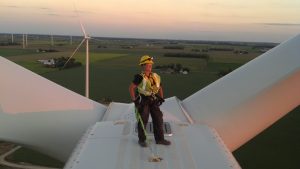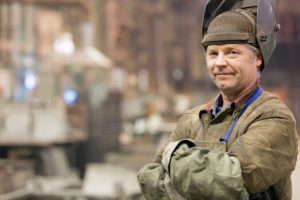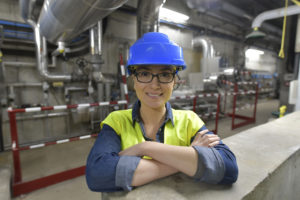Solidarity for Climate Action
Let policymakers know you support Solidarity for Climate Action, our plan to put working people front and center as we create a new economy: one that values our work, our families, our communities, and our environment.The BlueGreen Alliance and its labor and environmental partners are committed to the vision, principles, and policies outlined in this document, and are committed to a process of working together to identify concrete solutions to achieve these goals.
VISION
Americans face the dual crises of climate change and increasing economic inequality, and for far too long, we’ve allowed the forces driving both crises to create a wedge between the need for economic security and a living environment. We know this is a false choice—we know that we can and must have both, and we need a bold plan to address both simultaneously.
Many solutions are already being put into place across the country. For example, tradespeople built the Block Island offshore wind project off the coast of Rhode Island, autoworkers are on the factory floors building cleaner cars and trucks in Michigan, and previously unemployed workers in St. Louis and Los Angeles are gaining access to high-skilled jobs in energy efficiency retrofitting, pipefitting, and transit manufacturing, while mine workers are extracting palladium to be used in catalytic converters. These are all good, union jobs building a clean energy and climate-resilient economy today.
At the same time, not enough of the new jobs that have been created or promised in the clean energy economy are high-quality, family-sustaining jobs, nor are these jobs in the same communities that have seen the loss of good-paying, union jobs.
Wildfires, hurricanes, heat waves, droughts, and sea-level rise driven by climate change are hurting communities across the country and will only worsen if we don’t take decisive action. Lower income workers and communities of color are hit the hardest and are less able to deal with these impacts as wages have fallen and their economic mobility and power in the workplace has declined.
It is critical that working people are front and center as we create a new economy: one that values our work, our families, our communities, and our environment. It is with that imperative that we call for a new plan to create jobs and protect the environment for the next generation. This plan must respond to the climate crisis on the scale that science demands, while simultaneously addressing inequality in all its forms.
PRINCIPLES

Climate Stability: It is projected that the emissions path the world is currently on could result in an increase in global average temperature above pre-industrial levels of at least 2.5°C—and could exceed 4°C by 2100—if some countries do not fulfill their Paris Agreement commitments. This will have devastating impacts on both human communities and natural ecosystems. According to the Intergovernmental Panel on Climate Change’s (IPCC) Special Report on Global Warming, we must act now to shield workers and communities from increased climate disasters: “Limiting global warming to 1.5°C would require rapid, far-reaching and unprecedented changes in all aspects of society,” which “could go hand in hand with ensuring a more sustainable and equitable society.” This global effort to address climate change and inequality must happen at the speed and scale demanded by scientific reality and the urgent needs of our communities.
High-Quality Jobs: We must strive to create and retain millions of high-quality jobs while putting forward bold solutions to climate change. Unions are a primary vehicle to confront the economic insecurity most Americans face. Unions empower workers, create quality jobs, and sustain families. Making union jobs more accessible to all and increasing our nation’s union density will lift up all working people. When working people have power, they have greater capacity to fight for change.
Community Resilience: We must dramatically increase the capacity of the public sector, the health care system, and community-based non-profit sectors to prepare for and respond to the demands our changing climate places on first responders, healthcare workers, social workers, and others who deal with climate-induced disasters. We must also deal with the increasing stresses placed on communities and the health of workers due to more gradual manifestations of climate change. We need to expand public and private sector investments in our infrastructure and built environment that incorporate social, environmental, and economic considerations. We must support the efforts of frontline communities to adapt to and recover from the increased frequency and severity of climate change-induced natural disasters and impacts, ensuring that resources flow to those most impacted.

Repair America: We cannot address climate change with derelict infrastructure. It is time we made the long and deep commitment to fully and properly remake and modernize all sectors of our nation’s infrastructure, while also building out the new systems demanded by an advanced economy dealing with climate change demands. Infrastructure must be designed in ways that reduce emissions and that reflect projected conditions over its lifespan, including the ability to withstand the increased frequency and severity of climate-driven natural disasters.
Rebuild American Manufacturing: American leadership in inventing—and manufacturing—the most advanced technology of all kinds was once a cornerstone of a strong and growing middle class and a pathway for many out of poverty. U.S. manufacturing could be revitalized by building cutting-edge products and materials with clean, safe, and efficient industrial processes. A comprehensive national commitment to sustainably manufacture the next generation of energy, transportation, and other technologies in the United States will fully capture the benefits to workers and communities.
Clean Air, Clean Water, Safe and Healthy Workplaces and Communities: Tackling climate change goes hand in hand with ensuring that all workers and communities have access to clean air and water. We must also guarantee that our workplaces and communities are safe, clean, and free of hazardous chemicals and toxic pollution. This must include stepping up workplace protections and improving our industrial infrastructure through improved process safety and investments in inherently safer technologies.
Equity for Marginalized Communities: Generations of economic and racial inequality have disproportionately exposed low-income workers, communities of color, and others to low wages, toxic pollution, and climate threats. We must inject justice into our nation’s economy by ensuring that economic and environmental benefits of climate change solutions support the hardest hit workers and communities. Special attention must be given to the industries and communities that are most likely to be impacted by the effects of climate change and the transition to a clean economy.
 Fairness for Workers and Communities: Working people should not suffer economically due to efforts to tackle climate change. The boldness of any plan requires that the workers and communities impacted are afforded a just and viable transition to safe, high-quality, union jobs. We must also maintain a focus on reducing environmental burdens, continuing to be stewards of our air, water, and lands, and deploying technologies that are safe, as well as effective.
Fairness for Workers and Communities: Working people should not suffer economically due to efforts to tackle climate change. The boldness of any plan requires that the workers and communities impacted are afforded a just and viable transition to safe, high-quality, union jobs. We must also maintain a focus on reducing environmental burdens, continuing to be stewards of our air, water, and lands, and deploying technologies that are safe, as well as effective.
Promote Inclusive Public Dialogue: Workers and communities must have a central role in framing the problem and developing solutions to address climate change. Public dialogue between workers, employers, and governments should be present at all levels, from policy design to implementation and the measurement of results. Representatives of organized labor, community-based groups, and business associations should participate actively and equitably in dialogue at the enterprise, sectoral, and national levels to assess opportunities and resolve challenges posed by the climate transition.
POLICIES
 Greenhouse Gas (GHG) Emissions Reductions: To avoid the catastrophic consequences of climate change, we must significantly reduce the pollution that causes it. Doing so can and should benefit working people and communities across the country. As such, America must commit to implementing the following:
Greenhouse Gas (GHG) Emissions Reductions: To avoid the catastrophic consequences of climate change, we must significantly reduce the pollution that causes it. Doing so can and should benefit working people and communities across the country. As such, America must commit to implementing the following:
- Rapid GHG emissions reductions—based on the latest science and in line with our fair share—which would put America on a pathway of reducing its emissions to net zero emissions by 2050. The urgency required to stave off the worst impacts of climate change requires that by 2030 we are solidly on a path to net zero emissions;
- Deploy clean and renewable technology nationwide. Low-and-no carbon electricity production; carbon capture, removal, storage, and utilization; natural ecosystem restoration; and zero carbon transportation options are important parts of the solution;
- Make massive immediate investments in energy efficiency across all sectors;
- Utilize continual scientific review to inform and refine our progress; and
- Recommit to achieving our emissions reduction pledges under the Paris Agreement, and to restoring American leadership in global negotiations going forward.
 Infrastructure and Community Resilience: Our nation must move forward with an ambitious plan to rebuild and transform America’s infrastructure. If we do it right, we will boost our economy, create millions of jobs, and strengthen the resilience of our communities in their ability to prepare and respond to climate related disasters, while also reducing pollution and combating climate change. Strategic investments in infrastructure and a well-trained workforce—including significant investments in revitalizing our public sector workforce—can further ensure that our infrastructure and communities are prepared for the impacts of climate change and the challenges of the next century. Federal, state, and local governments play a crucial role in planning and leading our transition to a cleaner economy while responding to the growing threats of climate change. Our plan must include:
Infrastructure and Community Resilience: Our nation must move forward with an ambitious plan to rebuild and transform America’s infrastructure. If we do it right, we will boost our economy, create millions of jobs, and strengthen the resilience of our communities in their ability to prepare and respond to climate related disasters, while also reducing pollution and combating climate change. Strategic investments in infrastructure and a well-trained workforce—including significant investments in revitalizing our public sector workforce—can further ensure that our infrastructure and communities are prepared for the impacts of climate change and the challenges of the next century. Federal, state, and local governments play a crucial role in planning and leading our transition to a cleaner economy while responding to the growing threats of climate change. Our plan must include:
- Ambitious and strategic public investments to rebuild and modernize America’s infrastructure and make our communities more resilient—repairing our failing roads and bridges, replacing lead pipes and upgrading our water systems, stopping fugitive emissions from existing natural gas distribution pipelines, modernizing our schools, increasing the energy efficiency of new and existing buildings in all sectors from commercial to residential to hospitals and universities, expanding and modernizing our electric grid, building clean and affordable transportations systems, and redeveloping brownfields and cleaning up hazardous waste sites;
- Investment in the revitalization and expansion of the public sector workforce and ensuring staffing levels are sufficient to accomplish clean energy, resilience, adaptation, and crisis response objectives;
- Robust investments in natural infrastructure, including improving climate resilience through natural defenses that act as carbon sinks, recovering America’s wildlife, restoring forests and wildlands, reclaiming mines, and addressing the public lands maintenance backlog;
- Vigorous investment in broadband networks to close the digital divide, achieve universal access to high-speed Internet, and full utilization of the federally backed FirstNet network for first responders;
- Adaptation, resilience, and pre-disaster mitigation policies and investments, including sustainable land-use, housing, transportation, and natural infrastructure investments that are equitable, community-driven, and designed to uplift rather than uproot communities;
- Targeted policies and investments to communities with the most need and engaging local organizations to advocate, plan, and sustain positive development outcomes; and
- Prioritization of the use of the most efficient, resilient, and cleanest materials and products with the lowest carbon and toxicity footprints.
 Competitiveness, Strength, and Innovation: The economic strength of our country has long been connected to the well-being of the middle class. Yet, we can’t ensure prosperity if we’ve fallen behind the rest of the world in building the technologies of the future, and if working people and communities don’t see the gains from innovation and a cleaner economy. We need an aggressive agenda to regain American leadership in clean technology innovation, deployment, manufacturing, and good job creation. We can rebuild American competitiveness in the global economy, and secure and create a new generation of good, middle-class jobs across America through:
Competitiveness, Strength, and Innovation: The economic strength of our country has long been connected to the well-being of the middle class. Yet, we can’t ensure prosperity if we’ve fallen behind the rest of the world in building the technologies of the future, and if working people and communities don’t see the gains from innovation and a cleaner economy. We need an aggressive agenda to regain American leadership in clean technology innovation, deployment, manufacturing, and good job creation. We can rebuild American competitiveness in the global economy, and secure and create a new generation of good, middle-class jobs across America through:
- A national strategy to lead in clean and emerging technology production and supply chain development, including major investments in domestic advanced technology manufacturing and innovation, penalizing offshoring, and a commitment to at least doubling funding of clean technology research, development, manufacturing, and deployment:
- Application of strong Buy American and Davis-Bacon requirements, as well as utilization of project labor agreements, for all public spending, and procurement policies that ensure the use of domestic, clean, and safe materials made by law-abiding corporations throughout the supply chain;
- Environmentally, economically, and socially responsible mining projects and effective recycling initiatives for strategic materials necessary for a clean energy future;
- Investment in efficient domestic materials production and innovation to greatly limit the emissions associated with energy intensive manufacturing;
- Closing the carbon loophole and stopping the leakage of jobs and pollution overseas through procurement standards, sound trade enforcement, and border adjustments; and
- Ensuring trade agreements are enforceable, fair for all workers, and benefit the environment, including the climate.
 High-Quality Job Creation and Retention: American workers have faced wage stagnation, difficult working conditions, and a wholesale effort to decimate their ability to organize for the past several decades. Unionization offers the best pathway for quality jobs and more importantly a good, family-sustaining livelihood. A commitment to high-quality job creation across all sectors of the economy—but especially related to clean energy, adaptation, and resilience—will only be realized if we commit to:
High-Quality Job Creation and Retention: American workers have faced wage stagnation, difficult working conditions, and a wholesale effort to decimate their ability to organize for the past several decades. Unionization offers the best pathway for quality jobs and more importantly a good, family-sustaining livelihood. A commitment to high-quality job creation across all sectors of the economy—but especially related to clean energy, adaptation, and resilience—will only be realized if we commit to:
- Increasing union density across the country through strong support of the right to organize throughout the economy, including in the clean technology sectors;
- Remove policy barriers to organizing and promote productive policies to ensure that workers have a meaningful voice on the job;
- Applying mandatory labor standards that include prevailing wages, safety and health protections, project labor agreements, community benefit agreements, local hire, and other provisions and practices that prioritize improving training, working conditions, and project benefits. This includes respect for collective bargaining agreements and workers’ organizing rights such as neutrality, majority sign-up, and first contract arbitration for construction, operations, and maintenance;
- Raising labor standards in the non-construction sectors through improved wages and benefits and the prioritization of full-time work that eliminates the misclassification of employees and misuse of temporary labor;
- Investing in training, equipment, preparedness, plan development, and other tools including through registered apprenticeship programs to ensure a robust, skilled, and well-prepared workforce to address the extreme weather events and other impacts caused by climate change; and
- Maximizing the utilization and support for established training providers (such as registered apprenticeships, community colleges, and union training centers) and skill certifications for manufacturing.

Equity, Responsibility, and Safe and Healthy Communities: Justice and equity are critical aspects of any effective climate plan. We must utilize our collective power to solve climate change in ways that lift up all people and make every community more resilient against the impacts of climate change as well as changes in the economy. We must also make sure through this plan that communities are made safer and healthier. As such, America must commit to just solutions through:
- Community benefit, workforce, and other similar agreements that improve access to jobs and career paths, and identify and implement mechanisms to ameliorate and improve local economic and environmental impacts;
- Direct reduction of hazardous waste, toxic chemical emissions, particulate matter, and other non-GHG pollutants across the country, but first and foremost in frontline communities;
- Addressing cumulative environmental impacts that burden frontline communities with disproportionate air, water, and land pollution and climate risks;
- Improve the safety of our industrial facilities and protect workers, first-responders, and fence-line communities;
- Taking steps to avoid creating a “low-carbon, high-toxicity” economy, including reducing our toxicity footprints through investment and innovation in green chemistry;
- Ensuring that frontline communities and workers have equitable access to energy efficiency savings and clean, affordable energy, water, and transportations choices;
- Ironclad commitments to safe and healthy working conditions; and
- A recognition of our country’s opportunity and responsibility to help fund a clean energy economic development model for developing and emerging countries, including the transfer of technologies and capacity building, as well as assisting vulnerable developing countries in coping with the mounting impacts of climate change through ramped-up investments in adaptation and resilience strategies.

Fairness to Workers and Communities: America lacks a decent support system for people who have fallen through the cracks in our economy. Solutions that rely on or fail to address these systems are doomed to create new problems and ensure that America lags behind in the global race for a prosperous 21st century economy. As such, the United States must establish a globally competitive social safety net, including:
- Effective and equitable access to high-quality employment, training, and advancement for all workers, particularly those from low-income households, those historically under-represented on the basis of race, gender, and other criteria, and those adversely impacted or dislocated by technological change—notably including those in energy, transportation, and trade impacted communities;
- Guaranteed pensions and a bridge of wage support, healthcare, and retirement security until an impacted worker either finds new employment or reaches retirement;
- Dedicated community engagement including workers, community members, and leaders to support and enhance the development of the local economy;
- Massive economic investment in deindustrialized areas, including remediating any immediate loss of tax base or public services for communities;
- Mandated reclamation of closed and abandoned industrial sites to remediate deindustrialized blight, coupled with economic development and diversification; and
- Requirements for fair and safe working conditions throughout global supply chains.
Key Facts
Net Zero by 2050 Rapid GHG emissions reductions—based on the latest science and in line with our fair share—which would put America on a pathway of reducing its emissions to net zero emissions by 2050. The urgency required to stave off the worst impacts of climate change requires that by 2030 we are solidly on a path to net zero emissions.
Grow Unions Efforts to increase union density across the country through strong support of the right to organize throughout the economy, including in the clean technology sectors.
Repair America Rebuild and modernize America’s infrastructure and make our communities more resilient.
Lead the World A national strategy to lead in clean and emerging technology production and supply chain development, including major investments in domestic manufacturing and innovation, penalizing offshoring, and a commitment to at least doubling funding of clean technology research, development, manufacturing, and deployment.
Safe, Healthy Workplaces Ensure that our workplaces and communities are safe, clean, and free of hazardous chemicals and toxic pollution.
